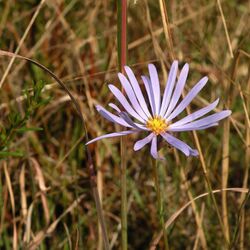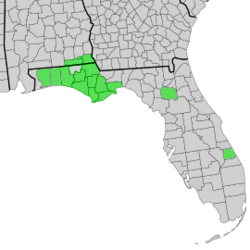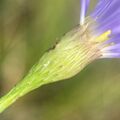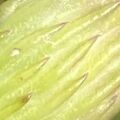Biology:Symphyotrichum chapmanii
| Symphyotrichum chapmanii | |
|---|---|

| |
| Symphyotrichum chapmanii, Apalachicola National Forest, Florida | |
| Scientific classification | |
| Kingdom: | Plantae |
| Clade: | Tracheophytes |
| Clade: | Angiosperms |
| Clade: | Eudicots |
| Clade: | Asterids |
| Order: | Asterales |
| Family: | Asteraceae |
| Tribe: | Astereae |
| Subtribe: | Symphyotrichinae |
| Genus: | Symphyotrichum |
| Subgenus: | Symphyotrichum subg. Chapmaniana |
| Species: | S. chapmanii
|
| Binomial name | |
| Symphyotrichum chapmanii | |

| |
| Native distribution[3] | |
| Synonyms[2] | |
| |
Symphyotrichum chapmanii (formerly Aster chapmanii and Eurybia chapmanii) is a species of flowering plant in the family Asteraceae native to the Apalachicola River drainage basin of Alabama and Florida.[4] Commonly known as savanna aster, it is a perennial, herbaceous plant that may reach 30 to 80 centimeters (1 to 2 1⁄2 feet) tall. Its flowers have purple to blue-lavender ray florets and pale yellow disk florets. It is a wetland species and is of conservation concern.[5] It may be extirpated in Alabama.[1]
Description
Savanna aster is a perennial, herbaceous plant that grows from a cespitose root system with rhizomes. It typically reaches heights 30–80 cm (12–31 in) on one to three hairless stems. It has cylinder-bell shaped involucres with green, purple-tipped phyllaries in 4–6 rows on its involucres. It blooms September–December with flower heads that have 8–23 purple to pale bluish-purple ray florets 10–20 mm (0.4–0.8 in) long surrounding 47–57 pale yellow disk florets.[5]
Bracts, involucre, and phyllaries
Citations
- ↑ 1.0 1.1 NatureServe 2021.
- ↑ 2.0 2.1 POWO 2019.
- ↑ USDA 2014.
- ↑ Semple 2014.
- ↑ 5.0 5.1 Brouillet et al. 2006.
References
- Flora of North America Editorial Committee, ed. (2006), "Symphyotrichum chapmanii", Flora of North America North of Mexico (FNA), 20, New York and Oxford, http://www.efloras.org/florataxon.aspx?flora_id=1&taxon_id=250067629, retrieved 14 July 2021
- "Eurybia chapmanii Chapman's Aster". Arlington, Virginia. 2 July 2021. https://explorer.natureserve.org/Taxon/ELEMENT_GLOBAL.2.149486/Eurybia_chapmanii.
- "Eurybia chapmanii". Natural Resources Conservation Service PLANTS Database. USDA. 2014. https://plants.usda.gov/core/profile?symbol=EUCH11.
- POWO (2019). "Symphyotrichum chapmanii (Torr. & A.Gray) Semple & Brouillet" (in en). Royal Botanic Gardens, Kew. http://www.plantsoftheworldonline.org/taxon/1157228-2.
- "Symphyotrichum subg. Chapmaniani Chapman's Aster". Ontario. 28 January 2014. https://uwaterloo.ca/astereae-lab/research/asters/symphyotrichum/symphyotrichum-subg-chapmaniani-0.
Wikidata ☰ {{{from}}} entry
 |






